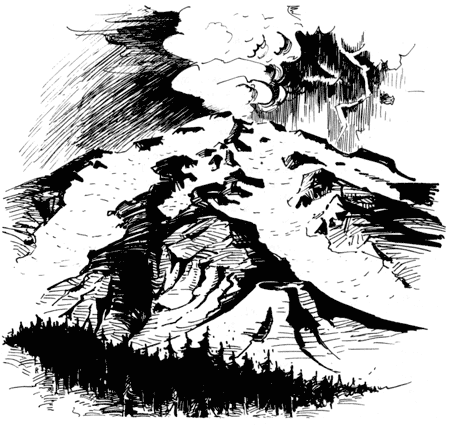Washington Lilies
By Dr. G. C. Ruhle, Ranger-Naturalist
Queen of American lilies is the real Washington Lily (Lilium washingtonianum), which grows in comparatively dry stands of brush in the arid Transition Zone from the Columbia River southward through the Sierras. Growing three to six feet tall, it bears clusters of a half-dozen or dozen very fragrant flowers that are white upon opening but turn first to pink, then to rose with age.
On the sunny manzanita-covered slopes of Copeland Ridge west of the lake at an elevation of 5500 feet, these lilies presented a superb display this year. Though frequently peering high above the red-boughed manzanita, some lower plants could be discovered by their sweet scent before they were detected by the eye.
The Retreat of Mount Mazama Glaciers
By William Kinsley
Glaciers once covered most of Mount Mazama and the country around its base. Howel Williams points out that during the stage of maximum glaciation, ice covered all but the highest pinnacles of the cascade divide.
The tremendous glaciers on the slopes of Mount Mazama have left scars in the form of U-shaped valleys. On the southern side of Crater Lake one can see Kerr, Sun, and Munson Valleys; all have the characteristic U-shape caused by moving rivers of ice. Here is mute testimony that large glaciers moved down the slopes of Mount Mazama, carving and gouging material from the sides of the valley. That material was ground into rounded boulders and fine sand; when the glaciers melted, the ground-up material was dropped in place forming glacial till.
Today the climate has changed to a point where only in the higher altitudes do the mountain peaks produce their rivers of moving ice. The geographers tell us that the average temperature of the world has been increasing is not known. Exactly what brings about this increase is not known. A decrease in temperature did occur over one million years ago that gave much of the land surface of our earth a coating of ice in the form of glaciers. This is called the Pleistocene Epoch or “Ice Age”. In many recently glaciated areas of the world geologists have found evidence that there were four periods during the Ice Age when the glaciers dominated these areas, and three periods between when the glaciers were all but extinct. The cause of these cycles of fluctuation must have been caused by widespread temperature variations on the earth. They may have been due to a variation in the heat intensity from the sun, or perhaps a change of the axis inclination of our earth. Either of these changes could have been enough to produce far reaching temperature effects on the surface of the earth.
Wallace Atwood Jr. studied the layers of glacial till that are interbedded with Mount Mazama lavas. He found many more deposits of glacial till than could be accounted for by these climatic cycles. Some other major cause must be sought for the retreats which dropped these additional layers.
Throughout much of the Ice Age, Mount Mazama was building itself. Tremendous eruptions of molten material were ejected from the top or sides of Mount Mazama and flowed down the slopes, cooling in the sharp, cool air. Other times great cinder showers with pumice or volcanic ash fell back on the slopes, adding their material in the building process. There must have been times when great ice flows rested on the slopes when these molten lavas or cinder showers came forth, and the picture of explosive steam clouds and rushing waters issuing from the glaciers is one of appalling clearness. The melted waters rushed down the canyons below the glaciers, carrying with them large trees and boulders, dropping their load only when the momentum of the flood died away. Quite often the glaciers were completely melted away when volcanic activity persisted long enough. Surely then, there were times when the glaciers disappeared due to volcanic activity of Mount Mazama and not due to any climatic change in the region.
Thus the retreat of Mount Mazama glaciers was governed by both climatic and volcanic conditions. Material dropped from retreating glaciers gives, as yet, no hint as to which influence caused the retreat. If the geologist can ascertain the rate at which these glaciers melted, he may have the fundamental answer to this problem. Volcanic action upon the glaciers will produce fast retreats, while climatic temperature increase will give rise to slow retreats. Somewhere the answers lie in the rocks around Crater Lake.


